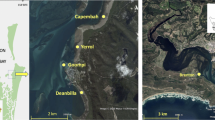Abstract
Balanus amphitrite was studied in an estuary (Halifax River) in central Florida from October to November 1990, while three other barnacle species were studied on the central coast (Monterey Bay) of California from April 1988 to July 1989. Mean nearest-neighbor distances indicated that in the majority of cases the spatial arrangement of settlers was random for three different balanomorph barnacles-B. amphitrite, B. glandula, and Chthamalus dalli. In Pollicipes polymerus, a lepidomorph species, strong aggregation among settlers was almost always observed. In the three balanomorph species there was no apparent relationship between settler density and the degree of aggregation. In P. polymerus there was a significant positive correlation between settler density and the degree of aggregation. Morphological differences between balanomorph and lepidomorph barnacles may influence the evolution of settlement behavior.
Similar content being viewed by others
Literature cited
Barnes, H., Barnes, M. (1958). Further observations on self-fertilization in Chthamalus sp. Ecology 39: p. 550
Barnes, H., Powell, H. T. (1950). The development, general morphology and subsequent elimination of barnacle populations (Balanus crenatus and B. balanoides) after a heavy settlement. J. Anim. Ecol. 19: 175–179
Begon, M., Harper, J. L., Townsend, C. R. (1990). Ecology: individuals, populations and communities Blackwell Scientific Publications, Cambridge, Massachusetts
Blower, S. M., Roughgarden, J. (1989). Parasites detect host spatial pattern and density — a field experimental analysis. Oecologia 78: 138–141
Crisp, D. J. (1984). Overview of research on marine invertebrate larvae, 1940–1980. In: Costlow, J. D., Tipper, R. C. (eds.) Marine biodeterioration: an interdisciplinary study. Naval Institutional Press, Annapolis, Maryland
Crisp, D. J. (1990). Gregariousness and systematic affinity in some North Carolinian barnacles. Bull. mar. Sci. 47: 516–525
Fairweather, P. G. (1988). Consequences of supply-side ecology: manipulating the recruitment of intertidal barnacles affects the intensity of predation upon them. Biol. Bull. mar. biol. Lab., Woods Hole 175: 349–354
Farrell, T. M. (1991). Models and mechanisms of succession: an example from a rocky intertidal community. Ecol. Monogr. 61: 95–113
Foster, B. A. (1987). Barnacle ecology and adaptation. In: Southward, A. j. (ed.) Barnacle biology. A. A. Balkema, Rotterdam, p. 113–133
Gaines, S., Brown, S., Roughgarden, J. (1985). Spatial variation in larval concentrations as a cause of spatial variation in settlement for the barnacle, Balanus glandula. Oecologia 67: 267–272
Gaines, S., Roughgarden, J. (1985). Larval settlement rate: a leading determinant of structure in an ecological community of the marine intertidal zone. Proc. natn. Acad. Sci. U.S.A. 82: 3707–3711
Hoffman, D. L. (1984). Size-frequency distribution patterns of the juvenile stages of the pedunculate barnacle, Pollicipes polymerus Sowerby, 1833 (Cirripedia, Lepadomorpha). Crustaceana 46: 295–299
Hoffman, D. L. (1988). Settlement and growth of the pedunculate barnacle Pollicipes polymerus Sowerby in an intake seawater system at the Scripps Institute of Oceanography, La Jolla, California. Pacif. Sci. 42: 154–159
Hoffman, D. L. (1989). Settlement and recruitment patterns of a pedunculate barnacle, Pollicipes polymerus Sowerby, off La Jolla, California. J. exp. mar. Biol. Ecol. 125: 83–98
Hui, E., Moyse, J. (1987). Settlement patterns and competition for space. In: Southward, A. J. (ed.) Barnacle biology. A. A. Balkema, Rotterdam, p. 363–376
Johnson, L. E., Strathmann, R. R. (1989). Settling barnacle larvae avoid substrata previously occupied by a mobile predator. J. exp. mar. Biol. Ecol. 128: 87–103
Lewis, C. A. (1975). Development of the gooseneck barnacle Pollicipes polymerus (Cirripedia: Lepadomorpha): fertilization through settlement. Mar. Biol. 32: 141–153
Mileikovsky, S. A. (1971). Types of larval development in marine bottom invertebrates, their distribution and ecological significance: a re-evaluation. Mar. Biol. 10: 193–213
Miller, K. M., Blower, S. M., Hedgecock, D., Roughgarden, J. (1989). Comparison of larval and adult stages of Chthamalus dalli and Chthamalus fissus (Cirripedia: Thoracica). J. Crustacean Biol. 9: 242–256
Morris, R. H., Abbott, D. P., Haderlie, E. C. (1980). Intertidal invertebrates of California. Stanford University Press, Stanford, California
Raimondi, R. T. (1988). Settlement cues and determination of the vertical limit of an intertidal barnacle. Ecology 69: 400–407
Rittschof, D., Branscomb, E. S., Costlow, J. D. (1984). Settlement and behavior in relation to flow and surface in larval barnacles, Balanus amphitrite Darwin. J. exp. mar. Biol. Ecol. 82: 131–146
Roughgarden, J., Iwasa, Y., Baxter, C. (1985). Demographic theory for an open marine population with space-limited recruitment. Ecology 66: 54–67
Ruppert, E. E., Fox, R. S. (1988). Seashore animals of the southeast. University of South Carolina Press, South Carolina
Shanks, A. L., Wright, G. W. (1986). Adding teeth to wave action: the destructive effects of wave-borne rocks on intertidal organisms. Oecologia 69: 420–428
Thorson, G. (1950). Reproductive and larval ecology of marine bottom invertebrates. Biol. Rev. 25: 1–45
Vandermeer, J. (1981). Elementary mathematical ecology. John Wiley & Son, Inc., New York, New York
Wu, R. S. S. (1980). Effects of crowding on the energetics of the barnacle Balanus glandula Darwin. Can. J. Zool. 58: 559–566
Wu, R. S. S. (1981). The effect of aggregation on breeding in the barnacle Balanus glandula Darwin. Can. J. Zool. 59: 890–892
Yale, A. B., Walker, G. (1985). Settlement of Balanus balanoides: the effect of cyprid antennular secretion. J. mar. biol. Ass. U.K. 65: 707–712
Author information
Authors and Affiliations
Additional information
Communicated by N. H. Marcus, Tallahassee
Rights and permissions
About this article
Cite this article
Satchell, E.R., Farrell, T.M. Effects of settlement density on spatial arrangement in four intertidal barnacles. Marine Biology 116, 241–245 (1993). https://doi.org/10.1007/BF00350013
Received:
Accepted:
Issue Date:
DOI: https://doi.org/10.1007/BF00350013




